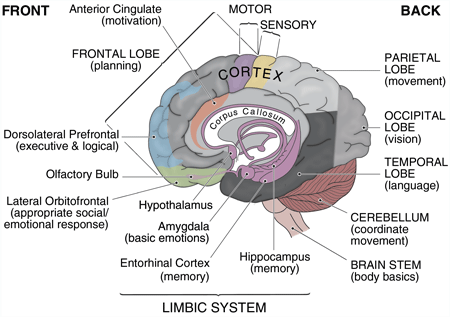
Even though we often use a single word to refer to “memory” as a whole, there are actually multiple different specific types of memory, which are responsible for many different mental processes and behaviors. There are also key differences in the various brain areas involved in storing and re-activating different types of memories. Read on to learn more about these differences, and the brain regions responsible for them!
Short-Term Memory
Short-term memory refers to holding amounts of information in an active, readily-available state for a short period of time.
For example, when you’re reading, in order to understand a sentence you need to keep the first part of the sentence in mind as you continue through to the end of it. This would be one particularly “short” example of “short-term” memory, since it unfolds over the span of just a few seconds.
Another example could be trying to hold a person’s phone number in your memory while you go to write it down. For many people, this might involve repeating the numbers in your head (“rehearsing” the information) – and if you got distracted by something else, the information might vanish from your mind entirely, since the information is not stored in your long-term memory, and has to be actively maintained.
In fact, phone numbers are great example of short-term memory, as many psychologists believe that the number of discrete “bits” of information the average person can keep in their active short-term memory is 7 – just like the number of digits in a phone number [1].
Working Memory
The term “working memory” is often used interchangeably with “short-term memory.” However, it technically refers to a slightly different set of processes, which generally include some kind of “manipulation” of (i.e. “working with”) the information that’s being stored in short-term memory.
One example of this could be trying to listen to a phone number – but then also subtracting ‘1’ from each digit, and then repeating the entire new 7-digit sequence back to someone.
In this case, “working memory” would include short-term memory, but would also include a variety of other cognitive systems that your brain is using to manipulate and update that information. In other words, you still have to remember the numbers themselves – but you also have to use other cognitive processes to use that information to produce the desired response.
However, this is often a subtle distinction, and there are many other contexts where people use these two terms to refer to roughly the same thing. For example, this difference might be important to keep in mind if you’re reading a technical scientific paper about psychology or neuroscience – but in most every-day, non-technical, contexts, these two terms usually mean roughly the same thing, and refer mostly to the act of keeping some information in active short-term memory (like the phone number example).
Long-term Memory
If information from short-term memory is important enough to keep around, practicing or “rehearsing” the memory will cause the brain to transfer it from short-term memory into long-term memory, so that it can be recalled and used at a later date.
However, “long-term” memory isn’t a single thing: it is actually made up of several different specific types of stable, long-term memory.
1) Explicit Memory
Explicit Memory is when you consciously memorize something, such as your new home address and zip code, or your personal social security number.
Declarative Memory is a type of explicit memory. Technically it refers to memories that can be consciously verbalized (“declared”). Examples of this might be the date of a certain historical event, the definition of a word, or the rules to a game.
There are three main “sub-types” of declarative memory:
- Semantic memory: the recall of general facts, a part of the declarative memory.
- Episodic memory: the recall of personal facts, a part of the declarative memory.
- Autobiographical memory: refers to knowledge about events and personal experiences from a person’s own life. While similar to episodic memory, autobiographical memory only pertains to the individual events.
2) Implicit Memory
Implicit memory is an unconscious form of memory that can affect thoughts and behaviors even when the specific details of that memory are not consciously (“explicitly”) remembered.
For example, maybe you visited a small town as a child, and then returned much later as an adult. Though you might never have been able to tell someone where the post office was located in that town, once you’re physically back in that environment you might discover that you suddenly can remember which corner it is on, and how to walk there.
In other words, you learned the layout of the town “implicitly”, even though you wouldn’t normally have been able to verbally (or “explicitly”) explain to someone where the post office was without actually being there yourself.
Implicit memory includes:
- Procedural memory: which helps you remember how to perform actions or skills. An example of this would be remembering how to drive or tying a shoelace even after not doing so for a long time.
- Emotional memory: memories that evoke a strong emotional response can have both declarative and procedural aspects.
Parts of the Brain Involved in Memory
- The Frontal Lobe: The frontal lobe is a very important coordinator of information, and thus important in working memory. The frontal lobe is also important for remembering what we need to do in the future, select relevant memories for a given occasion, and coordinating various types of information into a memory trace.
- The Temporal Lobe: The temporal lobe is the most associated with memory. Home of the hippocampus, the temporal lobe is associated with most forms of memory, including autobiographical memory and recognition memory.
- The Parietal Lobe: The parietal lobe helps us direct our attention to the task at hand, and is believed to assist with verbal short-term memory.
Other Parts of the Brain Involved in Memory
- Hippocampus (spatial and recognition memory): The hippocampus is usually the first part of the brain that suffers from damage over the course of Alzheimer’s disease [2]. The hippocampus also plays a big role in the transfer of short-term to long-term memory [3].
- Amygdala (emotional memory): Involved in the transfer of memories to long-term memories of emotionally arousing events.
- Cerebellum (procedural memory): The cerebellum plays a role in memory involving movement coordination and how to do repetitive day to day tasks.
- Prefrontal Cortex (process and retain information)
- Striatum or neostriatum (procedural memory): is important in the retrieval of procedural memory.
While different parts of the brain are associated with memory, learning and memory involve long-term potentiation (persistent strengthening of synapses), and long-term depression (long-lasting decrease in synaptic strength). These processes are involved synaptic plasticity.
Read this post to learn more about how to improve memory.


